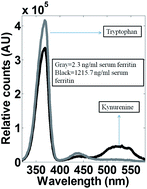Synchronous fluorescence based one step optical method for assessing oxidative stress and its dependence on serum ferritin†
Abstract
Sensing oxidative status with high accuracy provides a diagnostic/therapeutic advantage in various conditions. In this paper we report a synchronous spectroscopy based one step detection of the tryptophan/kynurenine (trp/kyn) ratio, a known indicator for oxidative stress. The method provides well resolved peaks for free tryptophan and kynurenine. By choosing the wavelength difference between excitation and emission monochromator 80 nm, we found emission maxima at 367 nm (trp) and at 520 nm (kyn). The ratio i367/i520 exponentially decreases with increasing serum ferritin concentration. The reciprocal relation of i367 and i520 suggests that the ratio actually measures the oxidative status, higher oxidative stress pertaining to higher ferritin concentrations. The reported inference is validated using serum samples from 54 thalassemic patients with varying degree of iron overloading. This also served as an antibody independent efficient ferritin indicator. We took another set of serum samples from 16 patients having iron related disorders for comparison of our proposed method with Comet assay, a method to assess the DNA damage due to oxidative stress. Higher serum ferritin containing samples results in higher Comet tail moment and lower value of i367/i520.


 Please wait while we load your content...
Please wait while we load your content...